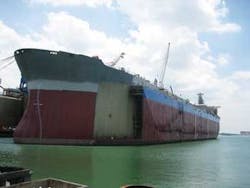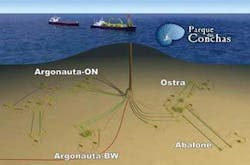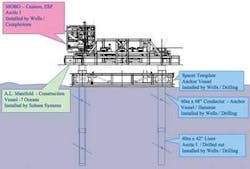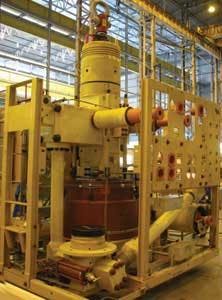Shell moves BC-10 forward
Gene Kliewer - Technology Editor, Subsea & Seismic
The closer Shell Brazil Ltda. gets to bringing BC-10 onto production, the more Perdido in the Gulf of Mexico takes shape. Sustainable development and building on Shell’s experience and standards are the by-words for both projects.
In so far as building upon its experience, Shell is drawing upon its lessons learned in bringing Bijupirá-Salema onstream to develop Parquet das Conchas, as BC-10 is known in Brazil. Bijupirá-Salema is in its fourth year producing 35,000 b/d of oil through an FPSO. That additional experience will be funneled into Perdido.
BC-10 offers plenty of challenges. It consists of six reservoirs in ultra deepwater from 1,600 m to 2,000 m (5,249 ft to 6,562 ft), and the oil gravity stretches from 16º API to 42º API, with the recent Abalone appraisal well late last year confirming the light oil. This light oil confirmation was welcomed as it will allow start-up of Phase 1 development without as much heavy oil. Production is from 900 m to 1,100 m (2,953 ft to 3,609 ft) below the mudline. Upon complete development, BC-10 is expected to produce 100,000 b/d as the capacity of the FPSO topsides.
As of press time, the project schedule called for manufacturing to continue with the spacer spool next, followed by the tubing head, first tree, umbilical terminals, PLET, the first artificial lift manifold, and then the first production manifold. These items are coming from FMC Technologies do Brazil Ltda.
Paul Dorgant, venture manager for BC-10, talked about the project in Shell’s Rio de Janeiro office. Among the key technologies necessary to develop BC-10, according to Dorgant, are:
- Surface BOP
- Electric subsea pump (ESP) caisson separation
- Umbilical capacity
- Deepwater riser configuration.
Surface BOP
Shell is using surface BOPs for drilling and completion. By doing this, Dorgant says Shell not only expands the list of rigs it can use by reducing the weight the rig has to support, but also permits use of high-pressure risers rather than the normal marine riser. Shell has used this approach in Brazil starting in 2002. The water depths for BC-10 and the extremely angled drilling used to penetrate thin producing horizons normally would require the most advanced type of rig. Shell avoids this by using the surface BOP and complements it by applying its own “lazy-wave” steel riser and umbilical configuration.
ESP caisson
Shell is drawing from a smaller application pioneered by Petrobras but scaled up to BC-10 volumes to separate the two-phase production flow at the seabed. Petrobras in 2000 worked on a vertical annular separator. The production flow enters the caisson at a tangent to establish a centrifugal force which sends the oil to the outside and leaves the gas in the middle.
“There is an optimization to flowing multiple wells into one caisson,” says Dorgant. “The caisson is basically a large, tubular ‘false well’ that goes to 100 m (328 ft) down. Production goes into that caisson and the ESP is inside the caisson. Production is commingled and separation occurs within the caisson. Liquids are pumped up the liquid line and gas flows up into the gas line. That has several benefits.”
One advantage is that it makes the ESPs more efficient and another comes in the case of intervention.
“We can flow production from the wells into different caissons,” says Dorgant. “We can change out an ESP without necessarily impacting production. It also allows efficient use of the risers and flowlines that we have.”
To accommodate the ESPs, there are six 48-in. (122-cm) conductors driven through subsea templates. These are 1500 hp ESPs, which brings up the issue of power.
Umbilical capacity
“We have an extension of technology in the high-power electrical umbilicals to provide the power to drive the ESPs,” says Dorgant. “The issue there is that we have a lot more power going down the umbilical and that gets more difficult to manage. It gets worse when you are in deepwater like we are. The challenge is to come up with the right mixture of the strength and flexibility to make it work.”
null
Riser/umbilical configuration
The lazy wave technology reduces the weight of the riser and umbilical by putting a buoyancy “wave” in the line part way to the surface which reduces the load at the set-down point. By reducing the fatigue on the lines, they can be larger, which, in the case of the riser, means there can be fewer. The lazy wave approach was used at Na Kika prior to BC-10. At BC-10, Shell is using the technology on both the umbilicals and risers.
EVDT developed for ultra deepwater completions
The Enhanced Vertical Deepwater Tree (EVDT) system was designed to bring versatility, installation savings, and operational efficiency to ultra deepwater, high pressure fields. Developed by FMC Technologies and Shell, the EVDT system is under construction in Rio de Janeiro for use on BC-10.
The EVDT was designed with a slimbore completion system. Outside diameter (OD) of the tubing hanger equipment is only 13 2/5 in. (34 cm) so it can pass through a 13 5/8-in. (34.6 cm) BOP stack. The bore of the system can accommodate 7 in. (17.8 cm) tubing completions and handle pressures up to 15,000 psi.
The EVDT allows for deepwater completions from a small drilling rig containing a surface BOP, thus avoiding the need for an expensive deepwater rig and subsea BOP system. Operators can save $5 million to $15 million per well by using the deepwater rig more effectively, focused on drilling operations only, says FMC.
Shell is planning to use the Generation 3 rigArctic 1 with a surface BOP for both drilling and completion at BC-10 offshore Brazil. Otherwise, Shell says, it would require a Generation 5 rig, if one could be found available.
In addition, the system increases installation efficiency with either configuration: with or without tubing head. In one, the tubing head is used for landing and orienting the tubing hanger, providing flexibility for offshore installation vessels and sequencing of events. For example, it allows the installation of jumpers before or after installing the tree.
In the other configuration, the tubing hanger lands directly into the wellhead and does not require the tooling or any of the common tree interfaces to be changed. Therefore, operators do not have to retrieve the subsea BOP and riser to conduct drilling and completion operations.
Another feature providing life-of-field value to operators is a retrievable flow module with meter incorporated into the EVDT design. This module and the flow meter can be retrieved and replaced in a matter of hours compared to several days required by the typical meter mounted in a flowline jumper. Reduced downtime could translate to more than $5 million in production revenue for a single change-out, says FMC.
The EVDT develpoment procees involved design, manufacturing, quality assurance, and procurement reviews from each of its major centers. The result is a globally accepted system that can be manufactured at any FMC Technologies facility in the world.
Already, the EVDT is a success in the offshore industry. First commercial orders have been received for Shell’s BC-10 and Perdido projects in Brazil and the Gulf of Mexico, respectively, as well as a 10-year supply agreement for their operations in Asia-Pacific. Additionally, Murphy Oil has placed orders for its Azurite project in Congo.
For its initial development, FMC Technologies worked with Shell to provide solutions for four major projects in different parts of the world. In order to minimize production time and reduce costs, Shell was anticipating a global solution that addressed all of its different projects. The unique development saved Shell in manufacturing costs. Because of that success, Shell has contracted for the installation of additional EVDTs in the near future. By aligning common systems across their various global projects, Shell can minimize production and maintenance costs.
Because of its flexibility, FMC Technologies is pursuing use of the EVDT in shallow water from a jackup rig. It is expected that this market could add another 20 to 40 trees per year in sales volume and revolutionize the use of subsea systems in shallow water.




